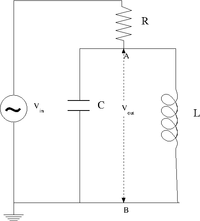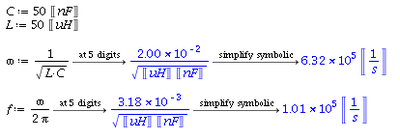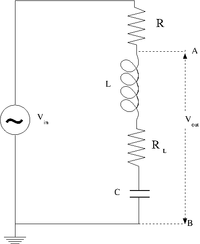Difference between revisions of "Lab 5 RS"
Jump to navigation
Jump to search
| Line 1: | Line 1: | ||
[https://wiki.iac.isu.edu/index.php/Electronics_RS Go Back to All Lab Reports] | [https://wiki.iac.isu.edu/index.php/Electronics_RS Go Back to All Lab Reports] | ||
| + | |||
| + | ;LC Resonance circuits | ||
| + | =The LC cicuit= | ||
| + | [[File:TF_EIM_Lab5_LC.png| 200 px]] | ||
| + | #Design a '''parallel''' LC resonant circuit with a resonant frequency between 50-200 kHz. use <math>L</math> = 10 - 100 <math>\mu H</math>, R = 1k | ||
| + | <math>\Omega</math> . | ||
| + | |||
| + | :<math>\omega_0=\frac{1}{\sqrt{\mbox{LC}}}</math> | ||
| + | |||
| + | I choose the following values for <math>\mbox{R}</math> and <math>\mbox{C}</math>: | ||
| + | |||
| + | :<math>R=aaa\ \Omega</math> | ||
| + | :<math>C=bbb\ \mu F</math> | ||
| + | |||
| + | So the resonance frequency is <math>\omega_0=\frac{1}{\sqrt{aaa\ \Omega\ bbb\ \mu F }} = ccc\ \frac{\mbox{rad}}{\mbox{sec}}</math> | ||
| + | |||
| + | Or <math>f=\frac{\omega_0}{2\pi} = ddd\ \mbox{kHz}</math> | ||
| + | |||
| + | |||
| + | Let's estimate: | ||
| + | |||
| + | [[File:L4 LC.png | 400 px]] | ||
| + | |||
| + | |||
| + | #Construct the LC circuit using a non-polar capacitor | ||
| + | #Measure the Gain <math>\equiv \frac{V_{out}}{V_{in}}</math> as a function of frequency. (25 pnts) | ||
| + | #Compare the measured and theoretical values of the resonance frequency (<math>\omega_{L}</math>) (10 pnts) | ||
| + | |||
| + | ==Questions== | ||
| + | |||
| + | #Is there a value of <math>R</math> in which <math>V_{out} \approx V_{in}</math> at resonance. What is the value?(5 pnts) | ||
| + | |||
| + | =The RLC cicuit= | ||
| + | [[File:TF_EIM_Lab5_RLC.png| 200 px]] | ||
| + | #Design and construct a '''series''' LRC circuit. | ||
| + | #Measure and Graph the Gain as a function of the oscillating input voltage frequency. (25 pnts) | ||
| + | #Measure and Graph the Phase Shift as a function of the oscillating input voltage frequency. (25 pnts) | ||
| + | ==Questions== | ||
| + | #What is the current <math>I</math> at resonance? (5 pnts) | ||
| + | #What is the current as <math>\nu \rightarrow \infty</math>? (5 pnts) | ||
| + | |||
| + | |||
| + | |||
| + | |||
Revision as of 16:31, 2 February 2011
- LC Resonance circuits
The LC cicuit
- Design a parallel LC resonant circuit with a resonant frequency between 50-200 kHz. use = 10 - 100 , R = 1k
.
I choose the following values for and :
So the resonance frequency is
Or
Let's estimate:
- Construct the LC circuit using a non-polar capacitor
- Measure the Gain as a function of frequency. (25 pnts)
- Compare the measured and theoretical values of the resonance frequency () (10 pnts)
Questions
- Is there a value of in which at resonance. What is the value?(5 pnts)
The RLC cicuit
- Design and construct a series LRC circuit.
- Measure and Graph the Gain as a function of the oscillating input voltage frequency. (25 pnts)
- Measure and Graph the Phase Shift as a function of the oscillating input voltage frequency. (25 pnts)
Questions
- What is the current at resonance? (5 pnts)
- What is the current as ? (5 pnts)
- LC Resonance circuits
The LC cicuit
Design a parallel LC resonant circuit with a resonant frequency between 50-200 kHz. use = 10 - 100 .
I choose the following values for and :
So the resonance frequency is
Or
Let's estimate:
Construct the LC circuit using a non-polar capacitor
Measure the Gain as a function of frequency. (20 pnts)
Measure the Gain when an external resistance approximately equals to the inherent resistance of the rf choke . (20 pnts)
Compare the measured and theoretical values from the resonance frequency () and the Quality factor value for each case; . (10 pnts)
Questions
- If r=0, show that . (10 pnts)
- Show that at resonance. (10 pnts)
The LRC cicuit
- Design and construct a series LRC circuit.
- Measure and Graph the Gain as a function of the oscillating input voltage frequency. (20 pnts)
Questions
- What is the current at resonance? (5 pnts)
- What is the current as ? (5 pnts)


